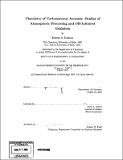Chemistry of carbonaceous aerosols : studies of atmospheric processing and OH-initiated oxidation
Author(s)
Johnson, Kirsten S. (Kirsten Sue)
DownloadFull printable version (35.92Mb)
Other Contributors
Massachusetts Institute of Technology. Dept. of Chemistry.
Advisor
Mario J. Molina.
Terms of use
Metadata
Show full item recordAbstract
Carbonaceous aerosols are among the most prevalent yet least understood constituents of the atmosphere, particularly in urban environments. We have performed analyses of field samples and laboratory studies to probe the physico-chemical properties of soot and organic aerosols in a complimentary approach to obtain information essential for understanding their atmospheric evolution and environmental effects. Samples of particulate matter < 2.5 pm in diameter (PM2.5) were collected from the Mexico City Metropolitan Area (MCMA) for both bulk compositional analysis and single particle characterization. Approximately 50% of the non-volatile component of PM2.5 was found to consist of carbonaceous material, including both soot and organics. Other major components included sulfates, soil/dust and heavy metals indicative of industrial emissions. Single particle analysis confirmed the prevalence of soot particles; our evidence suggests they quickly became internally mixed with sulfates and other inorganic compounds in a day or less through extensive processing during their atmospheric residence times. In the second half of our approach, a Quartz Crystal Microbalance - Chemical Ionization Mass Spectrometry (QCM-CIMS) system was developed to probe the OH-initiated oxidation of organic and soot thin films as atmospheric aerosol surrogates. Mass loss (volatilization) from the films was observed upon exposure to OH radicals in the presence of 02 at 295 K and 100 Torr. The loss rate was found to be linearly dependent on OH and independent of 02 concentrations over the range 02 _1012 to 2.1018 molec/cm3. A relatively slower mass loss rate in the presence of NOx suggests simultaneous formation of alkyl nitrate compounds potentially important in polluted urban environments. Experimental data were used to extract the rate constants of individual steps within the context of a previously proposed oxidation mechanism. Volatilization was observed in 15% relative humidity at a rate slower than under dry conditions, suggesting water adsorption to the surface. Initially hydrophobic alkane surfaces became noticeably hydrophilic as a result of oxidation. Although the oxidized surfaces did not exhibit measurable water uptake, water contact angle measurements show increased hydrophilicity, suggesting formation of polar (oxygen-containing) organic functional groups.
Description
Thesis (Ph. D.)--Massachusetts Institute of Technology, Dept. of Chemistry, February 2008. Includes bibliographical references (p. 133-151).
Date issued
2008Department
Massachusetts Institute of Technology. Department of ChemistryPublisher
Massachusetts Institute of Technology
Keywords
Chemistry.